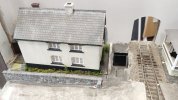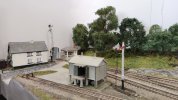I believe it's more common to have the lever push the first bit of rod when reversed, but as others have said, both are possible. You need to have equal amounts of push and pull to account for expansion (we've got one at the MHR that can be a real pig when it's hot, because half the run is in the shade, which disrupts the expansion). As it's LSWR, FPLs normally out (so the lever will be reversed to lock the points). I'd expect 'normal' route to be the main route through the platform.
The points leading to the dries would be hand operated. IMHO it's a short enough layout that all the points would be worked from the box, not needing an extra ground frame (max 180 yards in the early days, 350yds later), and there might be a common FPL lever for both the right-hand loop points and the goods yard ones, so I'd expect three black levers and two blue ones, plus signals and gate release.

![Underbase board drives [small].jpg Underbase board drives [small].jpg](https://www.westernthunder.co.uk/data/attachments/153/153962-c4cb500928965b9864eea319798ef18e.jpg)






